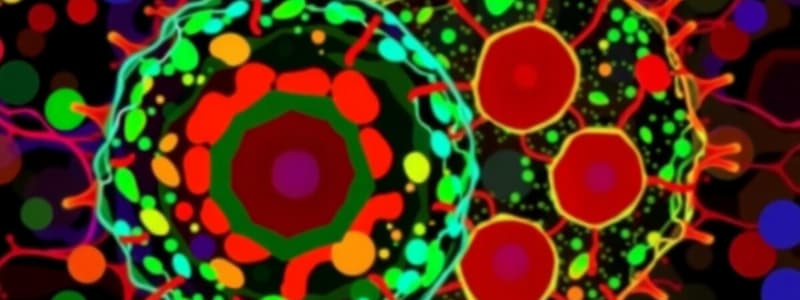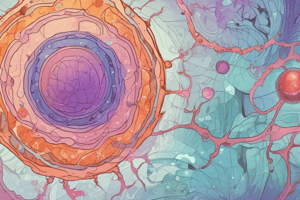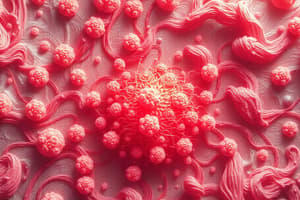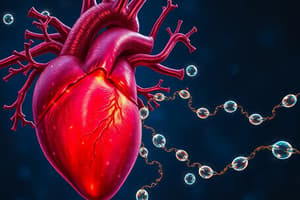Podcast
Questions and Answers
What pattern is seen in the arrangement of the letters and symbols presented?
What pattern is seen in the arrangement of the letters and symbols presented?
The letters and symbols follow a symmetrical pattern with the letter 'P' at the top center and 'B', 'M', 'V', 'S' positioned in a certain order below it.
Identify the repeated numerical values in the presentation and explain their significance.
Identify the repeated numerical values in the presentation and explain their significance.
'-25' and '24' are repeated, possibly indicating values or scores that have specific importance in understanding the context.
How does the structure of the letters reflect a logical hierarchy?
How does the structure of the letters reflect a logical hierarchy?
The arrangement has 'P' at the top followed by 'B', 'M', 'V', 'S', creating a hierarchy where 'P' is the most significant in the context.
Discuss the possible implications of the presentation format used.
Discuss the possible implications of the presentation format used.
What might the repeated sequences tell us about the content's purpose?
What might the repeated sequences tell us about the content's purpose?
What can be deduced from the repeating structure in the content provided?
What can be deduced from the repeating structure in the content provided?
How might the numerical values 25 and 24 relate to the other elements in the content?
How might the numerical values 25 and 24 relate to the other elements in the content?
What role do letters like 'P', 'B', 'M', 'V', and 'S' play in this structure?
What role do letters like 'P', 'B', 'M', 'V', and 'S' play in this structure?
In what ways could this structure be useful in real-world applications?
In what ways could this structure be useful in real-world applications?
What does the repetition of the same elements suggest about the underlying process or concept?
What does the repetition of the same elements suggest about the underlying process or concept?
How could you interpret the lack of additional information within the repeated sections?
How could you interpret the lack of additional information within the repeated sections?
If this content were part of a larger problem, what initial steps might you take to analyze it?
If this content were part of a larger problem, what initial steps might you take to analyze it?
What mathematical concepts could be represented by the alignment and placement of the symbols?
What mathematical concepts could be represented by the alignment and placement of the symbols?
Identify the main features depicted in the diagram. What do they represent?
Identify the main features depicted in the diagram. What do they represent?
What mathematical operation could be implied by the pattern of the numbers displayed (-25, 24)?
What mathematical operation could be implied by the pattern of the numbers displayed (-25, 24)?
Explain the significance of the numbers '-25' and '24' in the context of this diagram.
Explain the significance of the numbers '-25' and '24' in the context of this diagram.
What does the repeated structure within the diagram suggest about the system it represents?
What does the repeated structure within the diagram suggest about the system it represents?
Identify the significance of the letters 'P', 'B', 'M', 'V', and 'S' in the context provided.
Identify the significance of the letters 'P', 'B', 'M', 'V', and 'S' in the context provided.
Analyze the position of 'V' in the diagram. What role does it play?
Analyze the position of 'V' in the diagram. What role does it play?
Based on the patterns, what type of data visualization could these representations suggest?
Based on the patterns, what type of data visualization could these representations suggest?
What could 'r se' imply in the context of the diagram?
What could 'r se' imply in the context of the diagram?
What role does the repetition of the patterns play in understanding the mathematical concepts being illustrated?
What role does the repetition of the patterns play in understanding the mathematical concepts being illustrated?
Discuss how 'P' might interact with the other components in the system.
Discuss how 'P' might interact with the other components in the system.
Explain the potential implications of the number sequence starting from -25 and including 24.
Explain the potential implications of the number sequence starting from -25 and including 24.
How do you interpret the layout of the diagram's components?
How do you interpret the layout of the diagram's components?
What might the alignment of the letters and numbers suggest about the mathematical principles at play?
What might the alignment of the letters and numbers suggest about the mathematical principles at play?
What conclusions can be drawn from the systematic repetition of elements?
What conclusions can be drawn from the systematic repetition of elements?
Discuss how visual representation aids in understanding numerical sequences like those shown.
Discuss how visual representation aids in understanding numerical sequences like those shown.
How can the context of these patterns contribute to problem-solving skills in mathematics?
How can the context of these patterns contribute to problem-solving skills in mathematics?
Flashcards
Visual Aid
Visual Aid
A visual representation used to represent information or data, often used in presentations and reports.
Visual Communication
Visual Communication
The process of designing, creating, and presenting visual aids to enhance understanding and engagement.
Slide
Slide
A type of visual aid that uses a sequence of images to convey information.
Title slide
Title slide
Signup and view all the flashcards
Data slide
Data slide
Signup and view all the flashcards
Summary slide
Summary slide
Signup and view all the flashcards
List slide
List slide
Signup and view all the flashcards
Image slide
Image slide
Signup and view all the flashcards
Letter Pyramid
Letter Pyramid
Signup and view all the flashcards
Pyramid Formation
Pyramid Formation
Signup and view all the flashcards
The base of a pyramid is made of 2 letters.
The base of a pyramid is made of 2 letters.
Signup and view all the flashcards
How are letters stacked in a pyramid?
How are letters stacked in a pyramid?
Signup and view all the flashcards
How many letters are in each layer?
How many letters are in each layer?
Signup and view all the flashcards
How many layers does a pyramid have?
How many layers does a pyramid have?
Signup and view all the flashcards
How are letter pyramids arranged?
How are letter pyramids arranged?
Signup and view all the flashcards
How can we create different versions of letter pyramids?
How can we create different versions of letter pyramids?
Signup and view all the flashcards
Text Layout
Text Layout
Signup and view all the flashcards
Font Size
Font Size
Signup and view all the flashcards
Font Type
Font Type
Signup and view all the flashcards
Font Styles
Font Styles
Signup and view all the flashcards
Text Direction
Text Direction
Signup and view all the flashcards
Word Spacing
Word Spacing
Signup and view all the flashcards
Line Spacing
Line Spacing
Signup and view all the flashcards
Typography
Typography
Signup and view all the flashcards
What is a grapheme?
What is a grapheme?
Signup and view all the flashcards
What is a single grapheme?
What is a single grapheme?
Signup and view all the flashcards
What is a digraph?
What is a digraph?
Signup and view all the flashcards
What is a blend?
What is a blend?
Signup and view all the flashcards
What is a phoneme?
What is a phoneme?
Signup and view all the flashcards
Study Notes
Course Information
- Course Title: Development, Cell Biology & Cell Signalling
- Course code: 24-25
- Institution: Università di Pavia, Department of Molecular Medicine
- Lecturer: Virginie Sottile, PhD
Cell Phenotype Definition
- Cell phenotype is defined by gene expression
- Genes → mRNAs → Protein markers
- Processes involved
- Transcription
- RNA processing
- mRNA editing
- Translation
- Splicing
- Polyadenylation
- Translational regulation
Cell Types and Differentiation
- Diverse cell types have different gene and protein expression profiles
- These profiles lead to distinct cell phenotypes
- Cells go through processes of constant proliferation and differentiation (homeostatic cell turnover and regeneration)
- Stem cells (neoblasts) are involved in the process.
Cell Lineage Development
- Cell lineages develop through sequential stages of differentiation
- Diagrams show the development of cell lineages and the specific cells or cell types involved in development
- Various cell types have a lineage.
Experimental Models of Development
- Various animal models are used to study early events in development and organ/tissue development.
- Examples include;
- Human, Mouse, Chicken, Xenopus
- Zebrafish, Drosophila, C. Elegans
Developmental Biology
- Developmental biology uses animal models to study the early stages of embryo or organ/tissue development
- This includes processes like fertilization, embryogenesis, and fetal development.
- Diagrams show the different animal models used
- The slides shown embryos from various stages
- Diagrams illustrate the stages of development including fertilization, embryogenesis, cleavage, gastrulation, organogenesis, and formation of tissues.
Embryogenesis and Developmental Processes
- Embryogenesis encompasses the developmental stages from fertilization to the formation of new organs in an embryo.
- Steps include fertilization → cleavage → gastrulation → organogenesis
- Stages are shown in stages for amphibians
Cell Lineage Models
- First cleavage produces segregation of determinants
- Second cleavage creates diversity in daughter cells
- Cells acquire diverse fates
- Cells differentiate according to their lineage.
Cellular Interactions Models
- Cell diversity is generated among daughter cells via specific signals from other cells
- Daughter cells exposed to specific intercellular signals
Morphogen Gradients
- Localized RNA gradients produce protein gradients.
- Different levels of signalling trigger different gene expression
- Morphogen gradients lead to cell fate diversity.
Fine Regulation
- Fine regulation is achieved through gradients in inductive interactions
- Direct and indirect morphogen gradients create inductive interactions among cells, leading to sequential induction and cell fate diversity.
Molecular Patterning
- Diagrams illustrating interactions and signaling between different cells (A,B, C...).
- Sequential induction leading to cell type diversity.
- Example: animal cap from amphibian embryos (ectoderm cells) and (mesoderm-induced) presumptive endoderm cells.
Differentiation of Tissue
- BMPs signals from roof plate and Shh signals from floor plate control spinal cord patterning
- Different activin concentrations cause diverse gene expression in developing tissues
- Diagrams show these stages in different organisms like amphibian embryos
Signaling Pathways
- Intracellular signaling cascade.
- Diagram shows ligand-receptor-mediated signaling cascade from extracellular signal molecule binding to receptor protein to target proteins.
- Different signalling molecules, or different doses of the same molecule, lead to signal amplification and diversity in daughter cells
Key Signaling Pathways
- Various key pathways involved in regulating cell phenotypes
- Detail includes different pathways, pathways acting in early development and in later development, or function in the differentiation of specific cell types.
- Examples of pathways include Wnt, TGFβ, Shh, FGF, Notch pathways
Receptor Tyrosine Kinase Pathway
- Diagram shows the receptor tyrosine kinase pathway using FGF as an example
- Shows the interaction of FGF with its receptors and the intracellular cascade
- Discusses FGF receptors and how mutations in them can lead to developmental abnormalities
Notch-Delta Pathway
- Shows how cells exert inhibitory effects on each other
- Involves a signaling process from signaling cell to target cell and a process of cleavage and binding to Notch protein
- Example: control of neural fate
Studying That Suits You
Use AI to generate personalized quizzes and flashcards to suit your learning preferences.




